Egypt 2: Luxor - Walking in the Pharoah's footsteps
Morning doesn't really greet us, because we sleep behind curtains that shield the light to keep the apartment cool. So even though we're stumbling around in the dark sleepily, it's close to 9 am and the sun was already streaking its rays all over the city.
Today we fly to Luxor, which contains some of the most famous monuments of Ancient Egypt, as it is situated on the old capital city of Thebes. Neveen’s jolly Aunty Ohoud, a fun and really outgoing tour guide, organized this. We boarded the plane together for the 50 minute flight to Luxor.
I had not enjoyed a window seat more in my life. From 25,000 feet, I could see the desert plains of the Sinai Peninsula stretch across to the Red Sea. The scale of so much barren dry earth and shifting sand was awe-inspiring -- it makes you think twice about how much land is left arid, and if you were religious, consider what the tribes of Israel had to contend with during the Exodus.

Desert at 25,000 feet
The desert changes its face over the flight down the East Bank of the Nile. First flat and a light brown, it darkens and begins to show some contours, marked by twisting paths that are reminiscent of bubbling streams over this land. From 25000 feet the land looks like a blank canvas where dried riverbeds were little veins that creep across it like a spider's web.
Twists and Turns
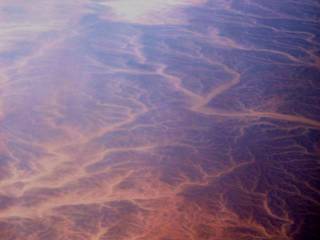
Twists and Turns
As we near Luxor, the desert finally meets the cultivated Nile Valley farmland. The Nile looks like a blue ribbon that cuts across the barren yellow sand, with borders of green on both sides of the river. It’s fascinating how abruptly the desert ends, cutting to the greenest of green fields. As the most cultivated area in the world, the Nile Valley certainly doesn't look very broad, just very very long.
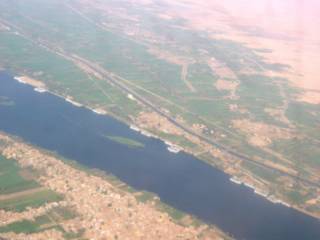
Nile at 25,000 feet
Landing in Luxor, the first blast of true desert heat makes my eyes water. This is it, I thought. This is what the desert is all about. In the mid-40's Celsius, I was told this was considered "cool" as the heat can reach Celsius 50's on bad days. Men wearing long flowing galabiyya's and white turban scarves call out their taxi fares to us, but Aunty Ohoud makes a beeline for one specific taxi, agrees a price, and we all head out to the Nile.
We crossed the border between desert and farmland, and green sped by our taxi instead of brown. The main crops in the Luxor area are corn, rice, and sugarcane. Sugarcane is especially lucrative because both of the largest sugar producers in Egypt are based in the Luxor area. Farmers here tend their own land, no sharecroppers or co-op farmers here.
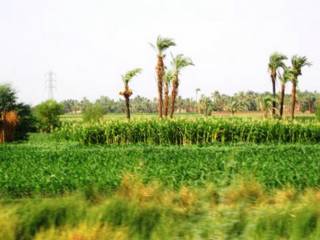
Main Crops in Luxor
We arrived at the Corniche (usual term to refer to promenade by the river) in Luxor, and boarded one of the many Nile cruise boats that were docked stern to bow against one another. Aunty Ohoud had arranged a room for us on the boat that she's going to be working on, we get to stay there but check out before the boat takes off for the famous Luxor-Aswan cruise down the Nile River. This works out admirably for us as we only have one stayover night in Luxor.
Our first adventure was to visit the center of Luxor -- Aunty Ohoud hired a hantur for us. A hantur is a horse buggy, the hantur driver was a dignified gentleman named Monsieur Ramadan, and his horse's name was Rambo. Riding in a horse buggy wasn't necessarily my idea of truly experiencing Luxor, but I have also come to realize that this is a demonstration of care and hospitality for a guest, so I decided to relax and enjoy it.
So off we went like two princesses driven in a carriage. Luxor center was not large - but it was cozy. And we went into a souk (street market), which got even cozier. With barely enough room to rub shoulders, the buggy maneuvered its way into the narrow winding streets-- the fruit sellers had to move their stalls to make way for Rambo. Neveen and I looked at each other and felt absolutely out of place to have to sit high up in a horse buggy while the poorer folk in Luxor make way for us. It was surreal. We asked to be let down to walk the souk, but Ramadan firmly said if he let us do so Aunty Ohoud would kill him so the answer had to be no.
There were carts selling everything ranging from breadsticks, batteries, rubber flip flops, combs, the largest watermelons I've ever seen, ratty old cactus pears, and every now and then there would be a cart with a little smoking coal stove used to roast corn or sweet potatoes. In the narrow alleyways these carts were squeezed right next to each other, the people nimbly avoided the horse while staring at us. Some called out greetings, others called out less friendly remarks. Older men who had seen many summers just ignore us, while kids with boundless energy would jump on the side of the hantur and ask for baksheesh. Women covered from head to toe in black slid alongside, continuing on their daily shopping routine - sometimes you could see a glimpse of their curious eyes looking our way. Behind this press of humanity were shop fronts that proudly displayed their wares in the windows or on the front steps. Gold, shoes, shisha pipes, clothes, headscarves, and most beautiful of all, spices.
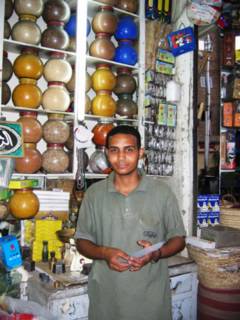
Spice Shop Man
A spice shop is indeed a golden shop, as some of these spices are not found anywhere else in the world. There were more familiar ones, like cumin and coriander, with scents that were more intense than their weak American counterparts. There was indigo (which is electric blue, interestingly enough), kirkider (dried hibiscus), sunny yellow ground saffron, dazzling colors in an otherwise spartan store. The shopowner was very welcoming, he gave me almost US$100 worth of spices for a measly 80 guinea - about US$13. And a little box of rose-scented incense as a present.
On the down side, we also passed a newly opened McDonald's in the town center. Enough said on that.
From the marketplace for the everyday man, we took a giant step back in time and started our journey to learn more about Ancient Egypt. Our first stop was Luxor Temple, which is curiously located smack in the middle of town, with a mosque in the heart of temple grounds. This is because before the temple was excavated by archeologists, a village was built on top of the site with a mosque in its midst. After discovering the temple, the village was relocated but no one wanted to move the mosque, so it now stands proud, a strange misfit amid pharoanic ruins.
There was an avenue that linked Luxor Temple with Karnak Temple, and it was lined with sphinxes on each side. This avenue once numbered over 75 sphinxes, there are now only 12 or so left.
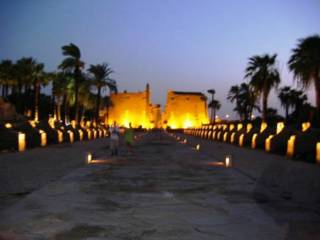
Avenue of the Sphinxes
The obelisks that the Pharoahs dedicated to the gods were hand carved and shipped up the Nile from Aswan as the best granite can only be found there. The master stonecutters calculated the precise measurements such that when one looked up at the obelisk from the ground, optically all the hieroglyphs looked the same size. The temples were gargantuan, columns rising at least 50 feet off the ground, wider than the arm-lengths of 6 people. Statues and carvings detailed the conquests of pharaohs, the legends of demigods, the political propaganda that bestowed upon human pharaohs the power of their supreme idols.

Prayer Carving
These hints of the existence of an entire civilization that walked the very flagstones we were treading on, were at least 3500 years old. Ancient Egyptian lifestyle, beliefs, rituals and customs were so foreign and on occasion quite brutal, but their accomplishments, intelligence, and prosperity were indeed worth marveling at. Every column or hieroglyph carving I looked at, I had to extend my imagination further to accept that it was over 3500 years old, and made by a people who have since disappeared.
Our next stop was Karnak Temple, a 15 minute hantur ride away. Karnak temple's awesome relics are, in my opinion, best viewed during the day - however the desert night deserves some space here.
Night-time in the Egyptian desert is a dream-like experience. Sand reflects moonlight, heat waves from the daytime simmer and turn the sky an unusual shade of indigo - a blue I have never seen before. This makes the moon a prominently bright orb - its presence behind these ancient relics is surreal and timeless. Palm trees and obelisks are visible under this moonlit night, you don't see their details but you can see their outlines and you can imagine their grandeur during the day.
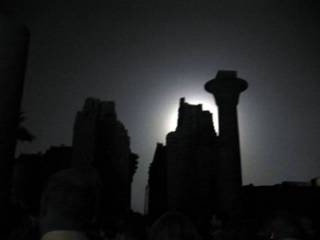
Karnak by Moonlight
The breeze may caress your cheeks, a gentler reminder of the scorching day. It carries with it a unique fragrance that hints of eons of history and whispers songs of the endless Nile. If you listened carefully, you can make out a distant echo of reed music. The air is balmy, a perfect complement to the rest of the night that throbs with life all on its own. It is a sultry, romantic, dreamy night, a whole other world. I could almost feel myself walking into a milk bath strewn with rose petals. Without much more effort, you can imagine the overwhelming passion that propelled an ancient civilization to such heights, and the emotional missteps that brought about its downfall.
Of course, on a more personal level, it was the perfect night to spend with a passion-stirring soul mate. Unfortunately Neveen and I were not that kind of friends.
But we did top the night off with a swim in the roof deck pool on the boat, sometime around 2 a.m. - we don't remember, we were seduced by the timelessness of the Egyptian night.
Next: Valley of the Kings... http://atygerontheloose.blogspot.com/2004/08/egypt-3-empires-lost-in-valley.html
Today we fly to Luxor, which contains some of the most famous monuments of Ancient Egypt, as it is situated on the old capital city of Thebes. Neveen’s jolly Aunty Ohoud, a fun and really outgoing tour guide, organized this. We boarded the plane together for the 50 minute flight to Luxor.
I had not enjoyed a window seat more in my life. From 25,000 feet, I could see the desert plains of the Sinai Peninsula stretch across to the Red Sea. The scale of so much barren dry earth and shifting sand was awe-inspiring -- it makes you think twice about how much land is left arid, and if you were religious, consider what the tribes of Israel had to contend with during the Exodus.

Desert at 25,000 feet
The desert changes its face over the flight down the East Bank of the Nile. First flat and a light brown, it darkens and begins to show some contours, marked by twisting paths that are reminiscent of bubbling streams over this land. From 25000 feet the land looks like a blank canvas where dried riverbeds were little veins that creep across it like a spider's web.
Twists and Turns

Twists and Turns
As we near Luxor, the desert finally meets the cultivated Nile Valley farmland. The Nile looks like a blue ribbon that cuts across the barren yellow sand, with borders of green on both sides of the river. It’s fascinating how abruptly the desert ends, cutting to the greenest of green fields. As the most cultivated area in the world, the Nile Valley certainly doesn't look very broad, just very very long.

Nile at 25,000 feet
Landing in Luxor, the first blast of true desert heat makes my eyes water. This is it, I thought. This is what the desert is all about. In the mid-40's Celsius, I was told this was considered "cool" as the heat can reach Celsius 50's on bad days. Men wearing long flowing galabiyya's and white turban scarves call out their taxi fares to us, but Aunty Ohoud makes a beeline for one specific taxi, agrees a price, and we all head out to the Nile.
We crossed the border between desert and farmland, and green sped by our taxi instead of brown. The main crops in the Luxor area are corn, rice, and sugarcane. Sugarcane is especially lucrative because both of the largest sugar producers in Egypt are based in the Luxor area. Farmers here tend their own land, no sharecroppers or co-op farmers here.

Main Crops in Luxor
We arrived at the Corniche (usual term to refer to promenade by the river) in Luxor, and boarded one of the many Nile cruise boats that were docked stern to bow against one another. Aunty Ohoud had arranged a room for us on the boat that she's going to be working on, we get to stay there but check out before the boat takes off for the famous Luxor-Aswan cruise down the Nile River. This works out admirably for us as we only have one stayover night in Luxor.
Our first adventure was to visit the center of Luxor -- Aunty Ohoud hired a hantur for us. A hantur is a horse buggy, the hantur driver was a dignified gentleman named Monsieur Ramadan, and his horse's name was Rambo. Riding in a horse buggy wasn't necessarily my idea of truly experiencing Luxor, but I have also come to realize that this is a demonstration of care and hospitality for a guest, so I decided to relax and enjoy it.
So off we went like two princesses driven in a carriage. Luxor center was not large - but it was cozy. And we went into a souk (street market), which got even cozier. With barely enough room to rub shoulders, the buggy maneuvered its way into the narrow winding streets-- the fruit sellers had to move their stalls to make way for Rambo. Neveen and I looked at each other and felt absolutely out of place to have to sit high up in a horse buggy while the poorer folk in Luxor make way for us. It was surreal. We asked to be let down to walk the souk, but Ramadan firmly said if he let us do so Aunty Ohoud would kill him so the answer had to be no.
There were carts selling everything ranging from breadsticks, batteries, rubber flip flops, combs, the largest watermelons I've ever seen, ratty old cactus pears, and every now and then there would be a cart with a little smoking coal stove used to roast corn or sweet potatoes. In the narrow alleyways these carts were squeezed right next to each other, the people nimbly avoided the horse while staring at us. Some called out greetings, others called out less friendly remarks. Older men who had seen many summers just ignore us, while kids with boundless energy would jump on the side of the hantur and ask for baksheesh. Women covered from head to toe in black slid alongside, continuing on their daily shopping routine - sometimes you could see a glimpse of their curious eyes looking our way. Behind this press of humanity were shop fronts that proudly displayed their wares in the windows or on the front steps. Gold, shoes, shisha pipes, clothes, headscarves, and most beautiful of all, spices.

Spice Shop Man
A spice shop is indeed a golden shop, as some of these spices are not found anywhere else in the world. There were more familiar ones, like cumin and coriander, with scents that were more intense than their weak American counterparts. There was indigo (which is electric blue, interestingly enough), kirkider (dried hibiscus), sunny yellow ground saffron, dazzling colors in an otherwise spartan store. The shopowner was very welcoming, he gave me almost US$100 worth of spices for a measly 80 guinea - about US$13. And a little box of rose-scented incense as a present.
On the down side, we also passed a newly opened McDonald's in the town center. Enough said on that.
From the marketplace for the everyday man, we took a giant step back in time and started our journey to learn more about Ancient Egypt. Our first stop was Luxor Temple, which is curiously located smack in the middle of town, with a mosque in the heart of temple grounds. This is because before the temple was excavated by archeologists, a village was built on top of the site with a mosque in its midst. After discovering the temple, the village was relocated but no one wanted to move the mosque, so it now stands proud, a strange misfit amid pharoanic ruins.
There was an avenue that linked Luxor Temple with Karnak Temple, and it was lined with sphinxes on each side. This avenue once numbered over 75 sphinxes, there are now only 12 or so left.

Avenue of the Sphinxes
The obelisks that the Pharoahs dedicated to the gods were hand carved and shipped up the Nile from Aswan as the best granite can only be found there. The master stonecutters calculated the precise measurements such that when one looked up at the obelisk from the ground, optically all the hieroglyphs looked the same size. The temples were gargantuan, columns rising at least 50 feet off the ground, wider than the arm-lengths of 6 people. Statues and carvings detailed the conquests of pharaohs, the legends of demigods, the political propaganda that bestowed upon human pharaohs the power of their supreme idols.

Prayer Carving
These hints of the existence of an entire civilization that walked the very flagstones we were treading on, were at least 3500 years old. Ancient Egyptian lifestyle, beliefs, rituals and customs were so foreign and on occasion quite brutal, but their accomplishments, intelligence, and prosperity were indeed worth marveling at. Every column or hieroglyph carving I looked at, I had to extend my imagination further to accept that it was over 3500 years old, and made by a people who have since disappeared.
Our next stop was Karnak Temple, a 15 minute hantur ride away. Karnak temple's awesome relics are, in my opinion, best viewed during the day - however the desert night deserves some space here.
Night-time in the Egyptian desert is a dream-like experience. Sand reflects moonlight, heat waves from the daytime simmer and turn the sky an unusual shade of indigo - a blue I have never seen before. This makes the moon a prominently bright orb - its presence behind these ancient relics is surreal and timeless. Palm trees and obelisks are visible under this moonlit night, you don't see their details but you can see their outlines and you can imagine their grandeur during the day.

Karnak by Moonlight
The breeze may caress your cheeks, a gentler reminder of the scorching day. It carries with it a unique fragrance that hints of eons of history and whispers songs of the endless Nile. If you listened carefully, you can make out a distant echo of reed music. The air is balmy, a perfect complement to the rest of the night that throbs with life all on its own. It is a sultry, romantic, dreamy night, a whole other world. I could almost feel myself walking into a milk bath strewn with rose petals. Without much more effort, you can imagine the overwhelming passion that propelled an ancient civilization to such heights, and the emotional missteps that brought about its downfall.
Of course, on a more personal level, it was the perfect night to spend with a passion-stirring soul mate. Unfortunately Neveen and I were not that kind of friends.
But we did top the night off with a swim in the roof deck pool on the boat, sometime around 2 a.m. - we don't remember, we were seduced by the timelessness of the Egyptian night.
Next: Valley of the Kings... http://atygerontheloose.blogspot.com/2004/08/egypt-3-empires-lost-in-valley.html

0 Comments:
Post a Comment
<< Home